#COSEWIC Assessment
Explore tagged Tumblr posts
Text
Unlocking the Secrets of Saskatchewan's Mushrooms
In the realm of fungi, Mushroom Day takes center stage on April 16th, inviting enthusiasts to delve into the fascinating world of mushrooms. With over 14,000 varieties, these fungal wonders grace dark and damp corners, adding a touch of mystery to the natural world. Mushrooms and fungi Despite their allure, caution is paramount. Harvesting mushrooms requires more than just an appreciation for…

View On WordPress
#biodiversity#Citizen Science#City Nature Challenge#Cosewic#COSEWIC Assessment#Ecological Awareness#ecological balance#environmental stewardship#Forest Biodiversity#Forest Exploration#Fungal Chronicles#Fungal Diversity#Fungal Ecology#Fungal Kingdom#Fungal Kingdom Exploration#Fungal Wonders#fungi#Fungi Appreciation#George Genereux Urban REgional Park#iNaturalist#iNaturalist app#Mushroom Day#Mushroom Discovery#Mushroom Enthusiasts#Mushroom Foray#Mushroom Identification#Mushroom Kingdom Celebration#Mushroom Photography#Mushroom Safeguarding#Mushroom Science
0 notes
Text
Bats can sing??!! (Wildlife Conservation Society Canada)

If you click on the link above, you can hear bat noises. Songs? Excerpt from this story from Wildlife Conservation Society Canada:
A new paper, published in the Wildlife Society Bulletin, documents only the second known instance of a North American bat singing. Based on recordings made outside two old mine sites used by silver-haired bats in British Columbia and a scattering of forest locations in western North America, researchers have concluded that these bats use sounds for more than echolocation or simple social calls.
This is a timely finding as silver-haired singing provides a useful way to distinguish this species from other bats that use similar echolocation calls, such as big brown bats and hoary bats. Both the hoary and silver-haired bats are migratory species, which are experiencing heavy mortality from wind power development. Both have been recently assessed by COSEWIC (Committee on Status of Endangered Wildlife in Canada) as Endangered. Conversely, big brown bats are one of the few Canadian bat species that is not considered at risk anywhere in Canada.
Being able to accurately determine which species are present in the area of existing or potential wind power developments can help with mitigation and monitoring. Being able to conclusively differentiate bat species using bat detectors only, without requiring capture, is a welcome species conservation tool at a time when wind energy development is poised to exponentially increase.
2 notes
·
View notes
Text
Turtles of Ontario
Beneath the calm surface of Ontario’s lakes and rivers lives an animal that has occupied the area for longer than any human civilization. But with the changes of the modern world, the ancient turtles of Ontario that once represented protection and longevity are quickly fading from existence. In today’s blog post, I will be exploring my favourite animal, the turtle, and share with you the unfortunate story of how this elder of the animal world has become rare in their native habitats, and how if action is not taken, we may never be able to see them again.
There are eight species of turtle that can call Ontario their home, the most of any Canadian province, each with unique characteristics that set them apart from the others. Turtles are reptiles that belong to the order Testudines, they have hard shells that have developed from their ribs and can hide their heads and limbs within the shell when threatened. Most turtles can be identified based solely on the patterns, size, and shape of their shells. One of the most commonly seen turtles in Ontario is the painted turtle. If you see a bunch of turtles lying on a log or rock, you’ve likely seen a painted turtle! These turtles love basking in the sun near the lakes, ponds, rivers, and wetlands that they live in. They are aquatic, spending most of their time in the water but will travel onto land to migrate, nest, and bask. They have a unique pattern of red stripes on their shells and limbs which can be seen in the picture below (COSEQIC, 2018).

The largest turtle in Ontario is the Snapping turtle, which can grow to 40cm in length! They are known not only for their size but also for their powerful bite, which they get their name from. Although their shells are large, their underside is not well protected, and they cannot fully retract their head and limbs (OTCC, 2023).

Another fascinating species is the Northern Map turtle, which lives in bodies of water in and around the Great Lakes. They get their names from the unique pattern on their shells of intricate lines that resemble that of a topographical map. They also like to bask on logs and other surfaces near the water but are quick to startle and will dive into the water at the slightest movement (OTCC, 2023).
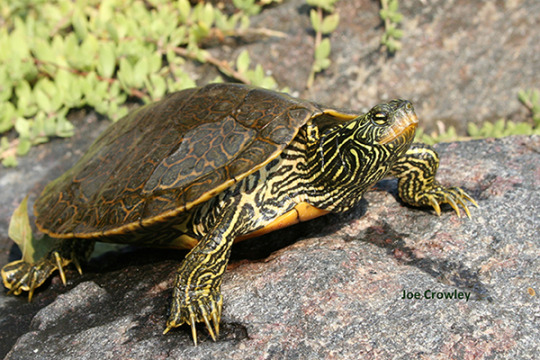
Unfortunately, seven of the eight Ontario species are considered at risk of extinction if steps are not taken to conserve their populations. They all face similar threats from human activities and suffer the most from roadway accidents, loss of habitat, and invasive species (OTCC, 2023). Turtles have long lives but take many years to reach sexual maturity, resulting in low rates of population growth. This combined with increased adult mortality has made population recovery a slow and difficult process. Being able to identify the different species of turtles in Ontario is crucial for reporting and monitoring their populations. There are many citizen science initiatives and reporting turtle sightings is an important step in their conservation. This can be done at the following website, but many others can be found with a quick search: https://www.ontario.ca/page/report-rare-species-animals-and-plants
COSEWIC. (2018). COSEWIC assessment and status report on the Midland Painted Turtle Chrysemys picta marginata and the Eastern Painted Turtle Chrysemys picta picta in Canada. Committee on the Status of Endangered Wildlife in Canada. Ottawa.
OTCC. (2023). Our 8 Native Species Need Our Help! Ontario Turtle Conservation Centre, retrieved from: https://ontarioturtle.ca/turtles/
5 notes
·
View notes
Text

Fish that Band Together: Banded Killifish in the Home Aquarium
A close relative of the more widely known (and distributed) Mummichogs, the Banded Killifish is an interesting choice for keeping in the home aquarium - and a better choice than its’ relative for freshwater keeping. Below is some information you should consider before selecting one or more of these guys for your home tank.
Species
Fundulidae (Topminnows) is one of the 10 families in the order Cyprinodontiformes (Toothcarps) along with Poeciliidae (Livebearers), Cyprinodontidae (Pupfishes), Rivulidae (Rivulines, New World Killifish), and Aplocheilidae (Killifish). Fundulus is a relatively large genus of 39 fish, all with different care requirements. Therefore the focus of this discussion will be:
Fundulus diaphanus (Banded Killifish) [pictured]
As far as I know, these fish are not sold at all in the trade - save for maybe through specialist dealers. Likely if you want one, you’ll have to collect them yourself.
Conservation Status
The Banded Killifish has been evaluated as Least Concern by the IUCN.
Description
The Banded Killifish is an elongated fish that can attain a maximum size of about 5 inches, though you’d be lucky to find one much above 3.5 inches. Males have a more prominent banding pattern on their sides and when in breeding condition gain a blueish iridescence. Females have a more subdued banding pattern with thinner bars; sometimes these aren’t overtly present at all. As with other Killifish, they do appear to have regional “variants” depending on where they are caught. The ones pictured were captured in Virginia.
Common for Topminnows, Banded Killifish are more territorial than aggressive on average. They will push other fish out of their turf but don’t typically continue to chase tankmates once they have fled. They can be tough on fish that don’t learn to stay out, though, such as some of the daces that swim all over the tank. They are more likely to leave fish alone that live on the bottom of the tank like darters and madtoms.
The best tankmates are either a) bottom feeders, or b) boisterous fish that can take care of themselves. Mudminnows, Darters, Madtoms, Mosquitofish, other Killifish, Fathead Minnows, and maybe Sticklebacks are all fair choices. In a brackish setting, consider Rivulines, native Gobies, Hogchokers, and maybe the smaller Sleeper Gobies.
As the name implies, these fish mostly inhabit the top of the tank, searching for floating morsels to eat. Their pattern makes them adept hiders and in a planted tank you may see them often lurking among the plants.
Feeding
I’ve found Banded Killifish to be very easy to feed. Dried Foods (flakes and pellets), frozen foods (brine shrimp, mysis shrimp, bloodworms, “marine” mixes), and live foods are all relished. They take to prepared foods right away - they push to be at the front of the chow line no matter what you feed.
Water Quality
Banded Killifish are best kept around room temperature (66-70 F), though can handle periods of much warmer or slightly cooler. They do best in basic, hard water - between 7.0 and 8.0 pH and 10-20 dH. They are more likely to inhabit smaller tributaries and marshes than fast moving streams, so ensure your tank turnover isn’t tumultuous.
Brackish Suitability
Banded Killifish thrive in brackish conditions. Laboratory tests showed they adapt well up to 1.010 and anecdotal evidence suggests they can live in full strength sea-water (1.025). That said, they strongly prefer freshwater - every specimen I’ve caught has been in totally freshwater conditions.
Tank Size
29 gallons is the starting point I’d use for a singleton with tankmates - if looking to add other killifish of the same species (or related) then I’d start at 55 gallons to allow all the space to coexist peacefully.
Breeding
Banded Killifish spawn during the summer, which can be replicated by increasing the temperature in the tank to 72-75 F. Eggs are deposited on algae or other filamentous media (like spawning mops used for other killifish) and hatch in 10-12 days. There is no parental care following hatching and fry may be consumed by the parents at this time.
Banded Killifish can interbreed with Mummichogs (and maybe other Fundulus Killifish). Keep this in mind if you keep them together.
Final Thoughts
Boisterous for sure, Banded Killifish are also easy to care for, very hardy, and not overly aggressive. In breeding colors, they are also quite attractive. I recommend them highly for home keeping.
Sources
Assessment and Status Report on the Banded Killifish, COSEWIC
Evolutionary variation in salinity tolerance among species of killifishes (Fundulus spp.), Jonah, Lauren Shea
(Image Source)
9 notes
·
View notes
Text
The Longest-Living Animals on Earth
Tortoises Fon't Even Make the Top 10 Longest-Living Animals.
— By Patrick Pester | Live Science
The animal kingdom boasts some incredibly long lifespans that far exceed the average human's. While humans may have an "absolute limit" of 150 years, this is just a blink of an eye compared with the centuries and millennia that some animals live through; and some animals can even stop or reverse the aging process altogether.
Although there are very long-living land animals (the oldest tortoise, for example, is nearly 190 years old), none of them make this list — the true age champions all live in water. From old to oldest, here are 10 of the longest-living animals in the world today.
1. BOWHEAD WHALE: POTENTIALLY 200+ YEARS OLD

Aerial view of a bowhead whale in the Sea of Okhotsk in Russia. (Image credit: by wildestanimal via Getty Images)
Bowhead whales (Balaena mysticetus) are the longest living mammals. The Arctic and subarctic whales' exact lifespan is unknown but stone harpoon tips found in some harvested individuals prove that they comfortably live over 100 years, and may live more than 200 years, according to the National Oceanic and Atmospheric Administration (NOAA).
The whales have mutations in a gene called ERCC1, which is involved with repairing damaged DNA, that may help protect the whales from cancer, a potential cause of death. Furthermore, another gene, called PCNA, has a section that has been duplicated. This gene is involved in cell growth and repair, and the duplication could slow aging, Live Science previously reported.
2. ROUGHEYE ROCKFISH: 200+ YEARS OLD

A vermilion rockfish swimming off the coast of California. This is a relative of the long-lived rougheye rockfish but not the same species. (Image credit: Brent Durand via Getty Images)
Rougheye rockfish (Sebastes aleutianus) are one of the longest living fish and have a maximum lifespan of at least 205 years, according to the Washington Department of Fish and Wildlife. These pink or brownish fish live in the Pacific Ocean from California to Japan. They grow up to 38 inches (97 centimeters) long and eat other animals such as shrimp and smaller fish, according to the Committee on the Status of Endangered Wildlife in Canada (COSEWIC), an independent advisory panel that assesses the status of species threatened with extinction in Canada.
3. FRESHWATER PEARL MUSSEL: 250+ YEARS OLD

Freshwater mussels from the Margaritifera genus. (Image credit: Irfan M Nur/Shutterstock.com)
Freshwater pearl mussels (Margaritifera margaritifera) are bivalves that filter particles of food from the water. They mainly live in rivers and streams and can be found in Europe and North America, including the U.S. and Canada. The oldest known freshwater pearl mussel was 280 years old, according to the World Wildlife Fund (WWF). These invertebrates have long lifespans thanks to their low metabolism.
Freshwater pearl mussels are an endangered species. Their population is declining due to a variety of human-related factors, including damage and changes to the river habitats they depend on, according to the International Union for Conservation of Nature (IUCN).
4. GREENLAND SHARK: 272+ YEARS OLD

Greenland shark swimming with isolated on black background. (Image credit: dotted zebra / Alamy Stock Photo)
Greenland sharks (Somniosus microcephalus) live deep in the Arctic and North Atlantic oceans. They can grow to be 24 feet (7.3 meters) long and have a diet that includes a variety of other animals, including fish and marine mammals such as seals, according to the St. Lawrence Shark Observatory in Canada.
A 2016 study of Greenland shark eye tissue, published in the journal Science, estimated that these sharks can have a maximum lifespan of at least 272 years. The biggest shark in that study was estimated to be about 392 years old, and the researchers suggested that the sharks could possibly have been as much as 512 years old, Live Science previously reported. The age estimates came with a degree of uncertainty, but even the lowest estimate of 272 years still makes these sharks the longest living vertebrates on Earth.
5. TUBEWORM: 300+ YEARS OLD
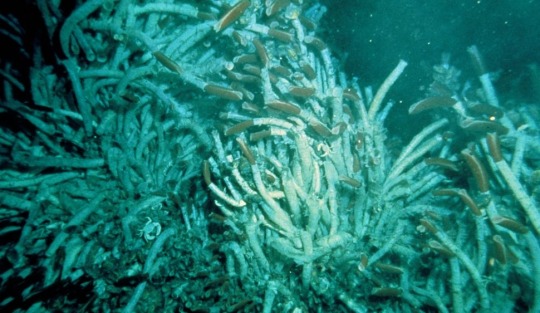
Tubeworms on the ocean floor. (Image credit: Ralph White via Getty Images)
Tubeworms are invertebrates that have long lifespans in the cold, stable environment of the deep sea. A 2017 study published in the journal The Science of Nature found that Escarpia laminata, a species of tubeworm living on the ocean floor in the Gulf of Mexico, regularly lives up to 200 years, and some specimens survive for more than 300 years. Tubeworms have a low death rate with few natural threats, such as a lack of predators, which has helped them evolve to have such long lifespans.
6. OCEAN QUAHOG CLAM: 500+ YEARS OLD

A quahog clam on a beach in Cape Cod in Massachusetts. (Image credit: Gabe Dubois/Shutterstock.com)
Ocean quahog clams (Arctica islandica) inhabit the North Atlantic Ocean. This saltwater species can live even longer than the other bivalve in this list, the freshwater pearl mussels. One ocean quahog clam found off the coast of Iceland in 2006 was 507 years old, according to National Museum Wales in the U.K. The ancient clam was nicknamed Ming as it was born in 1499 when the Ming Dynasty ruled China (from 1368 to 1644).
7. BLACK CORAL: 4,000+ YEARS OLD
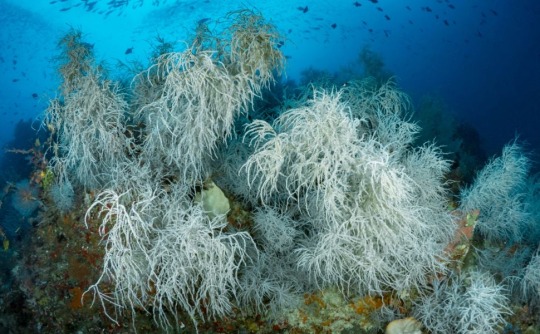
Black coral bushes on a reef. (Image credit: Mike Workman/Shutterstock.com)
Corals look like colorful, underwater rocks and plants, but they are actually made up of the exoskeletons of invertebrates called polyps. These polyps continually multiply and replace themselves by creating a genetically identical copy, which over time causes the coral exoskeleton structure to grow bigger and bigger. Corals are therefore made up of multiple identical organisms rather than being a single organism, like Greenland sharks or ocean quahog clams, so a coral's lifespan is more of a team effort.
Corals can live for hundreds of years or more, but deep-water black corals (Leiopathes sp.) are among the longest-living corals. Black coral specimens found off the coast of Hawaii have been measured to be 4,265 years old, Live Science previously reported.
8. GLASS SPONGE: 10,000+ YEARS OLD

An illustration of sponges, including Monorhaphis chuni (labeled 2 on the left). (Image credit: History and Art Collection/Alamy Stock Photo)
Sponges are made up of colonies of animals, similar to corals, and can also live for thousands of years. Glass sponges are among the longest living sponges on Earth. Members of this group are often found in the deep ocean and have skeletons that resemble glass, hence their name, according to NOAA. A 2012 study published in the journal Chemical Geology estimated that a glass sponge belonging to the species Monorhaphis chuni was about 11,000 years old. Other sponge species may be able to live even longer.
9. TURRITOPSIS DOHRNII: POTENTIALLY IMMORTAL

A Turritopsis immortal jellyfish off the coast of Palm Beach in Florida. (Image credit: Blue Planet Archive/Alamy Stock Photo)
Turritopsis dohrnii are called immortal jellyfish because they can potentially live forever. Jellyfish start life as larvae, before establishing themselves on the seafloor and transforming into polyps. These polyps then produce free-swimming medusas, or jellyfish. Mature Turritopsis dohrnii are special in that they can turn back into polyps if they are physically damaged or starving, according to the American Museum of Natural History, and then later return to their jellyfish state.
The jellyfish, which are native to the Mediterranean Sea, can repeat this feat of reversing their life cycle multiple times and therefore may never die of old age under the right conditions, according to the Natural History Museum in London. Turritopsis dohrnii are tiny — less than 0.2 inches (4.5 millimeters) across — and are eaten by other animals such as fish or may die by other means, thus preventing them from actually achieving immortality.
10. HYDRA: ALSO POTENTIALLY IMMORTAL

A photo of a Hydra, the small invertebrates that could be immortal. (Image credit: Choksawatdikorn/Shutterstock.com)
Hydra is a group of small invertebrates with soft bodies that look a bit like jellyfish. Like Turritopsis dohrnii, Hydras also have the potential to live forever. Hydras don't show signs of deteriorating with age, Live Science previously reported. These invertebrates are largely made up of stem cells, which continually regenerate through duplication or cloning. Hydras don't live forever under natural conditions because of threats like predators and disease, but without these external threats, they could be immortal.
5 notes
·
View notes
Photo
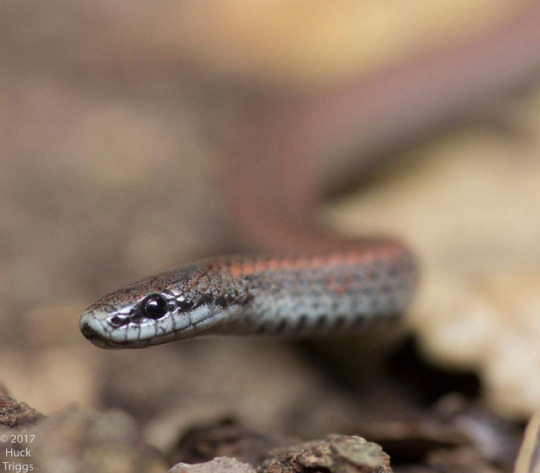
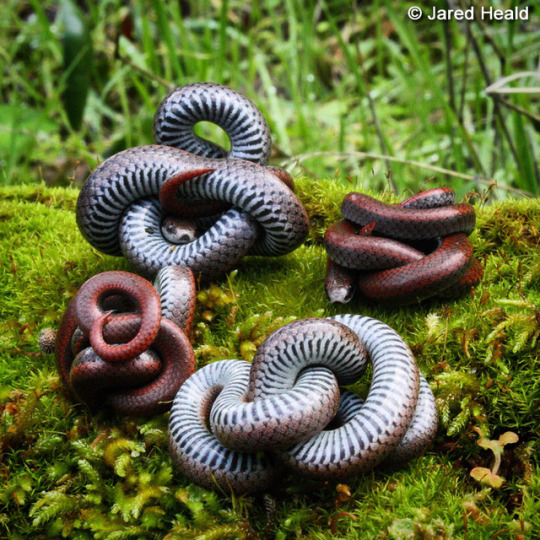
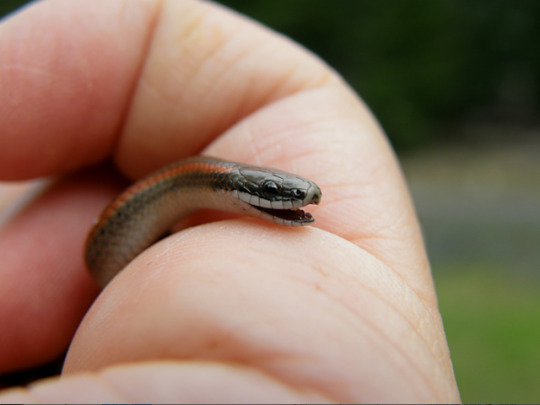
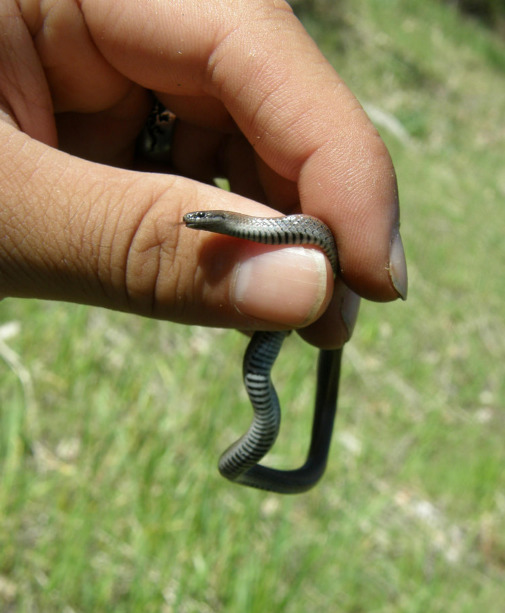
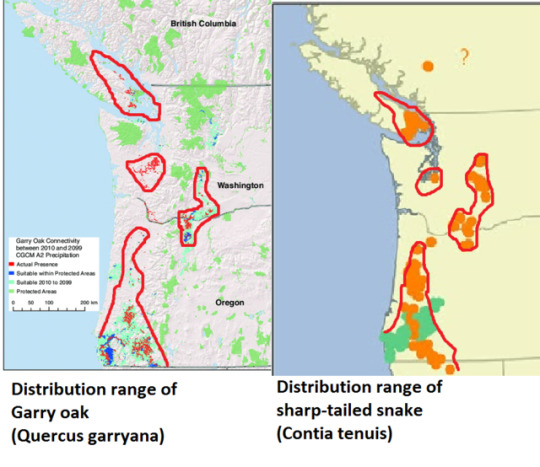
An iconic reptile of the Pacific Northwest and islands in the Salish Sea: the small and humble sharp-tailed snake
Image 1 - A sharp-tailed snake - By Huck Triggs, via Gary Nafis Image 2 - The defensive display of several sharp-tailed snakes - By Jared Heald, via Gary Nafis Image 3 - A sharp-tailed snake from Douglas County, Oregon - By pseudacris via Flickr Image 4 - A sharp-tailed snake from Jackson County, Oregon - By pseudacris via Flickr Image 5 - A comparison between the distribution ranges of the Garry oak (left, via Marlow Pellatt) and sharp-tailed snake (right, via British Columbia government)
Oh wow, it’s Contia tenuis (sharp-tailed snake), iconic snake on islands in the Salish Sea and an emblem of the highly-endangered Garry oak woodland biome. Currently my favorite North American snake species. If there is one, single snake that best represents the prairie and oak woodlands of the coastal Pacific Northwest, it’s probably this baby - a species endemic to the mild climates of the Pacific coast (a very rare quality for a reptile north of California).
The Pacific Northwest is cool and wet, so not many reptiles can make their home here. But the sharp-tailed snake is cold-tolerant and can deal with extra moisture on the forest floor. And besides - the snake loves to feed on slugs and snails, and the Pacific Northwest has no shortage of molluscs!
People who have lived on Vancouver Island might be familiar with this snake, since it’s an icon of endangered Garry oak (Quercus garryana) landscapes and it features heavily in conservation in and around Victoria. The sharp-tailed snake also has small disjunct populations on the Gulf Islands (San Juan Island; Saltspring Island; Galiano Island). They are closely-associated with oak savanna and prairie - and this is part of why they’re so special. Dry environments like this are rare in the Pacific Northwest, and I think it’s really cool how a reptile like this is able to survive in the midst of extensive rainforest by inhabiting small patches of dry habitat.
Similar to the ring-necked snake, this baby loves eating slugs and snails, so it’s deeply dependent on the types of intermittent woodland that are wet enough for molluscs but dry enough that reptiles can thermoregulate properly.
Here’s where they live:
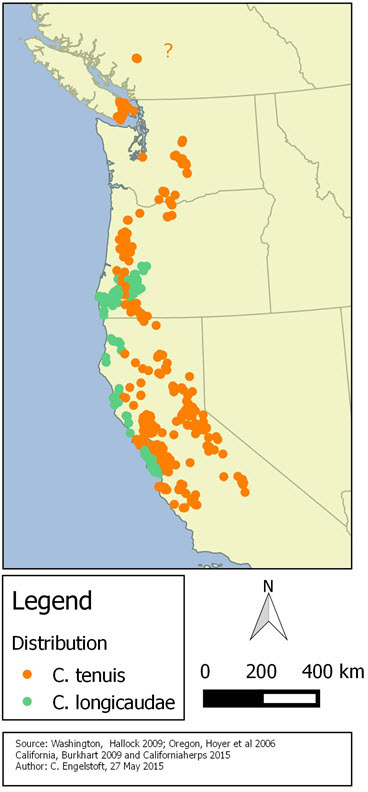
This map was taken from one of the best and most comprehensive assessments of sharp-tailed snakes, produced by British Columbia researchers for COSEWIC (available here). The species indicated as Contia longicaudae is the closely-related “forest sharp-tailed snake” - a sister species that prefers the redwood forest of the immediate coastline, and cedar-hemlock temperate rainforest in the Klamath Mountains.
The importance of Garry oak woodland
In contrast to the rainforest of the Pacific Northwest, Garry oak woodland is generally relegated to isolated valley bottoms. This means the snake lives in the trough and oak-dominated valleys between the Coast Range and the Cascades, which, north of California, includes the Rogue River area, Medford-Ashland area, Roseburg area, Willamette Valley, Puget Sound, and eastern Vancouver Island.
Compare the sharp-tailed snake’s distribution to the distribution of Garry oak woodlands, in the map included with the photoset above.
Here’s a view of the oak woodland habitat of the snake, from Lake County, California (photo by Gary Nafis).

And here’s a look at some habitat in Kittias County, Washington, on the eastern slopes of the Cascades where Garry oak woodland extends slightly into the Inland Northwest (photo by Gary Nafis).
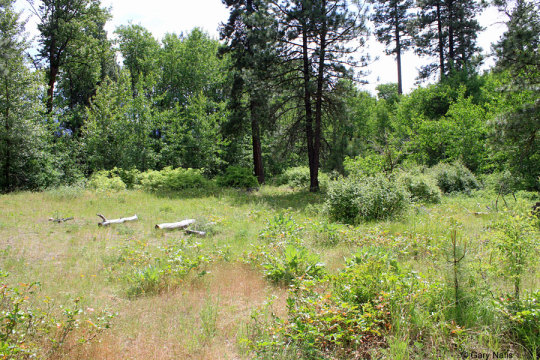
The snake’s distribution range is really uneven, since a lot of the Northwest’s oak woodlands are broken-up by intermittent dry coniferous forest and rainforest. There are some isolated populations east of the Cascades in central Washington’s Yakima Valley and Columbia River Gorge, though this place happens to be an eastward extension of the same Pacific grassland and oak savanna of the coast. (The Yakima/Gorge area in Washington is very distinct from the sagebrush steppe and Palouse grassland of the rest of eastern Washington; it’s like a little piece of Willamette Valley escaped the blockade created by the Cascades and spilled over into eastern Washington).
The importance of the Salish Sea
You can see where the sharp-tailed snake escaped glaciation by hiding-out on small islands in the Salish Sea near Victoria, British Columbia.
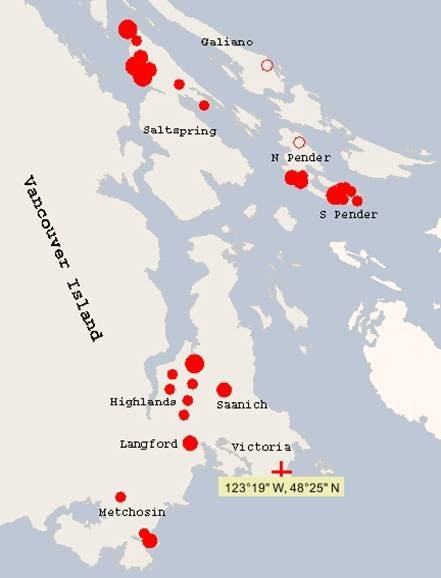
The sharp-tailed snake also has a small population on Washington’s San Juan Island. The Salish Sea provides an important habitat for reptiles in the Pacific Northwest, since its low elevation landscape sits in the rain shadow of the Olympic Mountains and Vancouver Island’s mountains. This means that prairies and oak woodlands can exist along the shore of the sea. Another iconic reptile of the Salish Sea is the Northwestern fence lizard (Sceloporus occidentalis occidentalis).
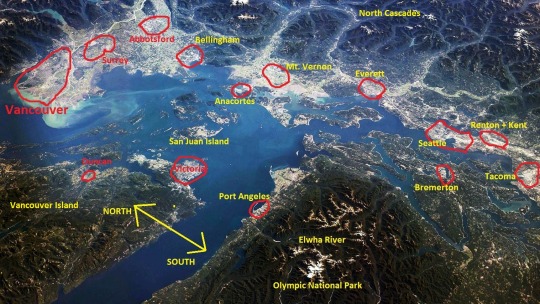
Because British Columbia ecologists provide such high-quality research, by visiting this site here, you can access far more specific information about all those separate little populations of the sharp-tailed snake on Vancouver Island (including population size, habitat specifics, ownership of the land, and projected climate affects on each area).
Aside from the sharp-tailed snake, there are 4 other snake species/subspecies which are tied closely with the Pacific Northwest. With the exception of 3 species/subspecies of gartersnakes and 1 subspecies of ring-necked snake - who love cooler weather and water, and can handle the PNW’s moisture - the sharp-tailed snake is the only other snake species that’s basically endemic to the Pacific Northwest coast west of the Cascades. (The sharp-tailed snake also lives in northern California, but west of the Sierra Nevada so it still counts as essentially endemic to “the coast.”) The only other non-snake reptiles that are so emblematic of and widespread in the coastal Pacific Northwest have to be the Northwestern alligator lizard (Elgaria coerulea principis), the Northwestern fence lizard (Sceloporus occidentalis occidentalis), and the Northern Pacific pond turtle (Actinemys marmorata).
-
Look at her.
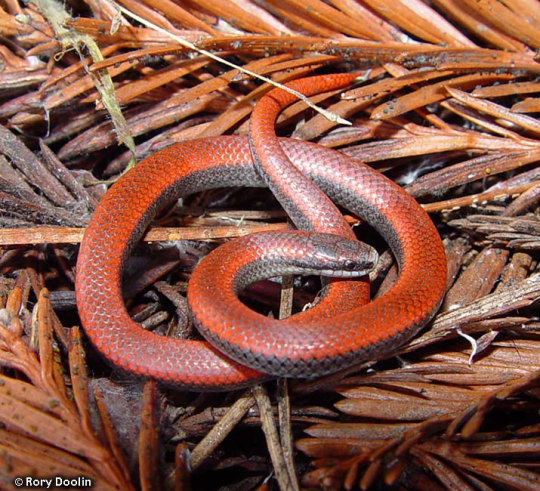
#sorry for that classic old-school Tumblr twee tone-of-voice here#thanks for indulging my hyper-fixations#i just really love these snakes#i'll probably talk more about PNW reptiles in the future if anyone's interested
29 notes
·
View notes
Text
The Polar Bear Poster Child
With technology advancing and the burning of fossil fuels becoming more prominent in our daily lives, our greenhouse gas emissions have reached a harmful rate. We are seeing changes in precipitation, dramatic increases in temperature, and higher chances of extreme weather events. Arctic sea ice is melting earlier than before and is decreasing at a rate of 12.85% per decade. This effect of climate change has lethal consequences for one of the most well-known arctic mammals, the polar bear.
youtube
A video of a starved polar bear, captured by Paul Nicklen.
I can confidently say that I am sure you have all watched this video before. The polar bear has become the poster child for the effects of climate change on wildlife, but there are so many additional species that are threatened or endangered that most people don’t know about. Here’s a few:
1) Peary Caribou (Rangifer tarandus pearyi)
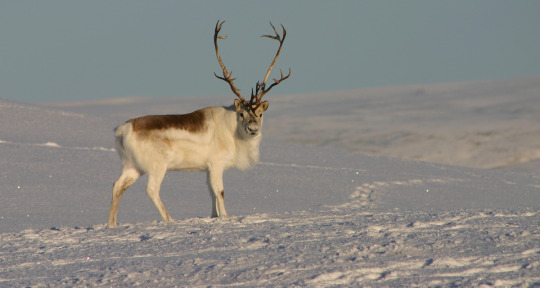
Image taken from Nature Canada.
The Species at Risk Act (SARA), introduced to Canada in 2002, has this subspecies of caribou listed as endangered. Because this species can only be found in the Northwest Territories and Nunavut, it is Canada’s job to protect our current populations. This caribou feeds on arctic vegetation, which is only available for a few months of the summer. During this short period of time, if the females are able to gain enough weight, they would ideally be able to reproduce annually. This rate of reproduction is all dependent on the severity of the passing winters, which vary from year to year. Multiple harsh winters in a row can wipe out an entire herd, whereas multiple mild winters in a row can reduce the caribou’s ability to travel from island to island and lead to a decrease in foraging ability. The warmer winters can lead to population growth, but with limited foraging the population will eventually take a hit. This reduction in population size decreases their genetic diversity, increases the rate of inbreeding and will therefore make them more susceptible to extinction. Other risks for this species include predation, habitat competition and hunting.
2) Blanding’s Turtle (Emydoidea blandingii)
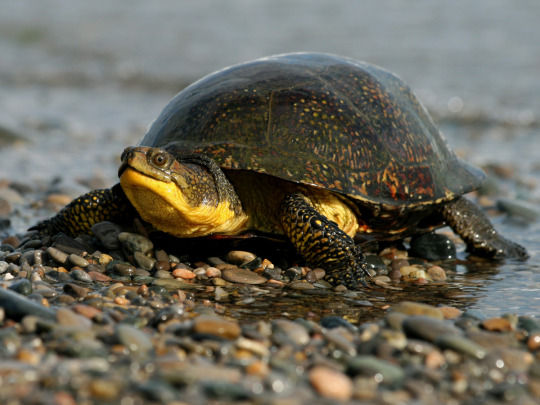
Image taken from Wildlife Preservation Canada.
The Blanding’s Turtle is another species that is listed as endangered under. Approximately 20% of the global abundance can be found in Ontario, Quebec and Nova Scotia. You can find these turtles in lakes, streams, marshes and swamps, as they prefer shallow water with lots of vegetation and nutrients. Females leave the water and look for nesting sites to lay clutches of 3-19 eggs every 2 or 3 years. Natural predators of this species include coyotes, skunks, foxes and racoons raiding the nesting sites. The real threat to the Blanding Turtle comes from increased human activity, as wetlands become more developed and increased traffic heightens the risk of vehicles striking and killing them.
3) Gray Fox (Urocyon cinereoargenteus)

Image taken from the government of Ontario’s website.
The Gray Fox has been listed as a threatened species under SARA and a 2015 assessment from the Committee on the Status of Endangered Wildlife in Canada (COSEWIC). This species of fox is part of the dog family (Canidae) and can be found in Manitoba, Ontario, and Quebec. This nocturnal species feeds on small rodents and vegetable matter, making it easy to inhabit both deciduous forests and the outskirts of cities. The Gray Fox disappeared from Canada during the European settlement and did not return until the 1930’s and 1940’s, as the US populations expanded their ranges northward. Sightings of this fox species is very rare and due to this, the explanation for the decline in its population is unknown. The predicted threats are vehicle collisions, canine distemper, rabies and predation from larger predator species.
I have just told you about three endangered or threated Canadian species that most people don’t know about, but there are still so many more! You may feel like you have no impact on them, but every little bit helps! So, if you see a Gray Fox report your sighting to The Ministry of Natural Resources or if you see a turtle trying to cross the road, help it along in the direction it is travelling. You have an impact and your actions can make a difference!
References
Berrigan, M. (2018, October 15). Blanding's Turtle. Retrieved from https://naturecanada.ca/discover-nature/endangered-species/blandings-turtle/.
Leishman, C. (2018, October 15). Gray Fox. Retrieved from https://naturecanada.ca/discover-nature/endangered-species/gray-fox/.
Peary Caribou. (2018, October 15). Retrieved from https://naturecanada.ca/discover-nature/endangered-species/peary-caribou/.
1 note
·
View note
Text
Pika mouse

#Pika mouse free
Sugimori and Nishida don’t explain why the two-evolution requirement was dropped, but it’s pretty easy to imagine it was a result of Pikachu’s design being unbelievably adorable. Odds are when Nishida showed her design to the rest of the staff, the reaction from many was “looks like a mouse,” making the name “Pikachu” a perfect fit.īut wait, what about the stipulation that the character be able to evolve twice? Pikachu can only evolve once, into Raichu (though later games added in the diminutive Pichu as the lowest level of the evolutionary path). As a matter of fact, squirrels themselves aren’t nearly as common in Japan as they are in rural and suburban communities in America, and if you live in a Japanese city, you could easily go several years without seeing one, even in parks. So why did the character end up being called Pikachu instead of Pika-whatever-squirrels-say-in-Japanese? Probably because there’s no set onomatopoeia for a squirrel’s cry in Japanese. So she turned to the animal kingdom for inspiration, and took design cues from…a squirrel!
#Pika mouse free
The only specific guidelines Nishida was given were that the character should be cute, use electricity-based powers, and be able to evolve twice.Īside from those criteria, Nishida was free to do whatever she wanted in terms of design. Ken Sugimori, head of Pokémon video game developer Game Freak, and Atsuko Nishida, an illustrator who contributed monster designs for the series’ original Pokémon Red and Green installments in 1996, recently reminisced about Pikachu’s origin. It’s the perfect name for a character that’s essentially an “electric mouse,” right?Įxcept, it turns out that Pikachu’s visual design wasn’t based on a mouse at all. As a matter of fact, the franchise mascot is so famous that even most non-Japanese speaking fans know that his name comes from a pair of Japanese onomatopoeias: pika, referring to a flash of light, and chu, the squeaking sound mice make. Slowpoke? Over here he’s “Yadon,” a syllabic jumbling of doya, which refers to a sort of blissful cluelessness.īut Pikachu’s name is the same around the world. For example, the Pocket Monster called Magikarp in English versions of the game/anime? In Japan, he’s “Koiking,” since he’s essentially a koi (“carp”) with a crown-shaped fin on his back. Perhaps my strangest experience with learning Japanese has been having to remember two sets of names for Pokémon species. Leaves of Mountain Avens, lupines, vetches, grasses and shrubs.Original designer reveals that the real inspiration for the “electric mouse” was a different animal altogether. The pikas call is a loud, distinctive “meeeep” and they use it to declare their territories. They are solitary creatures preferring to stay 20 to 75 metres away from their neighbours. They do not hibernate and so must have a food supply on hand to survive the cold months. Inconspicuous bobbed tail, long whiskers.Ĭollared Pikas spend the summer months raising young and collecting plants into hay piles among the rocks to save for the winter.Small chubby body with short limbs and rounded ears.Read the Protocol for detecting Collared Pika. Voluntarily report your observations to the Yukon Conservation Data Centre. The Committee on the Status of Endangered Wildlife in Canada (COSEWIC) has assessed Collared Pika as a species of Special Concern. In late summer and fall, look for conspicuous collections of plants, called ‘hay piles’ among the rocks.Once near its home territory, you may find that the pika will approach within a few metres, if you are able to remain nearly motionless and quiet for a few minutes.Hone in on the call and watch for movement among the rocks, or a silhouette of the pika against the sky. Although they are heard, they are not necessarily easy to see as they camouflage perfectly among the rocks. They can be easily found because of their alarm call that carries across the alpine when you walk by.Collared Pikas live in rock talus patches high in the alpine.Coney, Rock Rabbit, Whistling Hare Viewing opportunities

1 note
·
View note
Text
Fwd: Postdoc: UManitoba.SturgeonEvolution
Begin forwarded message: > From: [email protected] > Subject: Postdoc: UManitoba.SturgeonEvolution > Date: 9 April 2020 at 07:48:50 BST > To: [email protected] > > > > Postdoctoral Position in Sturgeon genomics and transcriptomics > > Under the Canadian Species At Risk Act the Committee on the Status > of Endangered Wildlife in Canada (COSEWIC) recently reaffirmed their > recommendation that Lake Sturgeon be listed as endangered or of special > concern across Canada. Three of the four designatable units of Lake > Sturgeon populations in Canada are found in Manitoba and an intensive > research effort supported by NSERC and Manitoba Hydro in partnership > with indigenous stakeholders, conservation groups, and provincial and > federal legislative bodies has been ongoing for at least the last five > years forming part of a long-term commitment to augment, conserve > and sustain populations of Lake Sturgeon throughout the province > and North America. Understanding underlying genetic variation within > these populations is key to the success of this research effort. In > collaboration with colleagues from UC Davis this research will develop > tools to sequence, assemble and annotate the polyploid genome of Lake > Sturgeon providing a valuable resource for understanding phenotypic > development during early life history and therefore development of > appropriate rearing practices for stock enhancement programs. > > A maximum of four years of funding is available for a post-doctoral > salary commensurate with NSERC guidelines. This position will be > responsible for directing genome sequencing, assembly and annotation > of the lake Sturgeon genome. Additionally, existing transcriptomic > datasets will be available for assessment of transcriptomic responses to > environmental factors in Lake Sturgeon related to growth and regulation > of pH balance. The successful candidate will join a multidisciplinary > research team examining environment phenotype interactions during early > life history and developing tools for improving our use of eDNA and > elemental signatures to understand effectiveness of stock enhancement > strategies in the conservation of this ancient species. Extensive > knowledge and experience in the use of bioinformatic tools is an essential > for this position, prior experience in working with polyploid datasets > is a distinct asset. Interested candidates should email a cover letter > and CV to Dr. W. Gary Anderson [email protected]. > > > Dr. W. Gary Anderson, > > Professor, > Dept. Biological Sciences, > Room 475 Duff Roblin Building, > University of Manitoba, > Winnipeg, MB > Canada, R3T 2N2 > Tel: (204) 474-7496 > > Gary Anderson > via IFTTT
0 notes
Photo

#barnswallow taking a short break on the ground to chase down a snack. #barn swallows are listed as #atrisk in the #nwt and COSEWIC has assessed them as #threatened #speciesatrisk #birding #birder #swallows #birdnerd #urbanwildlife #borealforest #yellowknife #northwestterritories #conservation (at Yellowknife, Northwest Territories)
#barnswallow#threatened#nwt#northwestterritories#swallows#yellowknife#barn#birder#conservation#atrisk#urbanwildlife#birding#speciesatrisk#borealforest#birdnerd
2 notes
·
View notes
Text
References
CPAWS. 2008. Gatineau Park: A Threatened Treasure. Canadian Parks and Wilderness Society, Ottawa Valley Chapter. Retrieved from http://cpaws.org/uploads/pubs/booklet_gatineau.pdf
COSEWIC. 2015. COSEWIC assessment and status report on the Eastern Wolf Canis sp. cf. lycaon in Canada. Committee on the Status of Endangered Wildlife in Canada. Retrieved from http://www.sararegistry.gc.ca/default.asp?lang=En&n=65C48F31-1
Spence, Christie and Callaghan, Carolyn. 2013. Biodiversity: Wolves in Gatineau Park? Newsletter of the Friends of Gatineau Park. Retrieved from https://www.friendsofgatineaupark.com/uploads/7/7/0/5/77054035/bulletin-2013-2_eng.pdf
NCC. 2014. Conservation status of Gatineau Park. National Capital Commission Workshop: Responsible Trail Management. Retrieved from http://s3.amazonaws.com/ncc-ccn/documents/threats_to_gp_and_fragmentation_-_unofficial_trails_june_16_2014.pdf?mtime=20170504155619
Soulard, Danielle. 2017. Impacts of Recreational Trails on Wildlife Species: Implications for Gatineau Park. University of Ottawa. Retrieved from https://ruor.uottawa.ca/bitstream/10393/36819/1/Soulard_Danielle_Impact_of_Recreation_Trails_on_Wildlife_Species.pdf
0 notes
Text
SAVE AN ENDANGERED SPECIES DAY APRIL 17, 2020
Small Yellow Lady’s Slipper – Cypripedium parviflorum Courtesy James St. John cc2-0
Horned Grebe Podiceps Auritus
Horned Grebe Podiceps Auritus Nesting
Horned Grebe Podiceps Auritus
Horned Grebe Podiceps Auritus
Save the Critical Habitat of the Horned Grebe. A facebook fundraiser https://www.facebook.com/donate/164658128131085/
Ontario takes the preservation of this endangered species very seriously and has compiled a management plan. The Ontario Ministry of Natural Resources considers species at risk, natural, valued and protected, and to this end have documented ways to help the Horned Grebe. What does the Province of Saskatchewan say? The Species at Risk Act SARA, similarly has a recovery strategy. Committee On The Status Of Endangered Wildlife In Canada COSEWIC has an assessment and status report written up for the Horned Grebe Podiceps auritus. The Government of Canada has developed a species profile and action plan in its Species at Risk Act Action Plan Series.
Did you know that “The federal, provincial, and territorial government signatories under the Accord for the Protection of Species at Risk (1996)Footnote2. agreed to establish complementary legislation and programs that provide for effective protection of species at risk throughout Canada?”
In 2018, Saskatchewan’s Wildlife protection act was 20 years old, and it was found then that the Sask. law falls short when it comes to protecting wildlife: prof
EcoJustice has written up a report; Failure to Protect: Grading Canada’s Species at Risk Laws. This is the Government of Canada Activity Set Back Distance Guidelines for Prairie Plant Species at Risk and the Wild Plant and Animals Protected news release from Saskatchewan Environment and Resource Management Minister.
“Mother nature has given us a strong signal through this pandemic: we must change our habits and slow down if we are going to continue living on this planet. It is a perfect time to make people realize on a global level that flattening the curve of climate change and environmental destruction is just as important as flattening the curve for COVID-19. It’s a perfect time to formulate and refine your ideas and put the planning and strategy in place to make them happen.” Marianna Muntianu UN Environment Program
The Saskatchewan Government reports; “Despite many programs focused on maintaining and enhancing wildlife populations, some species have become threatened with extinction and require special attention to help ensure their survival. The mission of the Saskatchewan species at risk program is to protect species from extirpation or extinction and to prevent new species from becoming threatened with extinction. ”
The Government of Saskatchewan protects species at risk and their habitats from risks to their survival associated with human activity.
The Canadian-Saskatchewan Agreement on Species at Risk; “Species at risk protection and recovery in Saskatchewan will, to the extent possible, be designed and delivered in a manner tailored to address the ecological, social and economic circumstances of the province; Planning and actions to prevent species from becoming at risk, and to protect and recover species that have been identified as being at risk will be informed by the best available information on the biological status of a species, including scientific knowledge, community knowledge and aboriginal traditional knowledge”
So, as one can see, there are numerous plans and strategies in regards to the Horned Grebe. What exists Nationally, Provincially and Municipally for the other endangered species which exist in the afforestation area locally? Both the horned grebe and barred tiger salamander are listed as a species of special concern by the Committee On The Status Of Endangered Wildlife In Canada – an Independent Advisory Panel to the Minister Of Environment and Climate Change. The Red-necked Phalarope, Baird’s Sparrow and Grasshopper Sparrow are special concern, and Bobolink, Bank Swallow is threatened nationally under the federal Species at Risk Act SARA Schedule 1. According to Chet Neufeld, Executive Director Native Plant Society referencing “the provincial rare species database, there have been occurrences of endangered Whooping Cranes observed near the area in 2017 and an occurrence of Small Yellow Lady’s-slipper (date unknown)” (email Dec 25, 2019) The Small Yellow Lady’s Slipper was indeed confirmed with another sighting by the Saskatoon Nature Society.
On Friday April 17, there are 5 days before the April 22 and the 50th birthday of Earth Day celebration! This year’s Earth Day 2020 theme is Climate Action, which will be explored during Earth Month.
At Nature Saskatchewan the Stewards of Saskatchewan program are calling for people to reach out to them with species at risk sightings as the spring season begins. If you have a sighting you would like to share please call 1-800-667-4668 (HOOT) or email a program staff member.
April 19, 2020 is the cutoff date for this crowd fundraiser should you care to do your part for the environment during Earth Month. Any funding raised would help to erect motorized vehicle barriers to protect the afforestation areas, and therefore protect the wetlands from illegal motorized vehicle trespass.
Shoreline edge of the permanent wetlands in the Richard St. Barbe Baker Afforestation Area with cattails and emergent vegetation in the summer showing illegal vehicle trespass, mudding, and ruts in the spring
with cattails and emergent vegetation in the summer showing illegal vehicle trespass, mudding, and ruts in the spring

Thanks for comments, likes and shares on facebook. And if you care to make a donation too 😉 Not only do vehicle mitigation barriers help the Horned Grebe, but they also help school children, class field trips from being run over from illegal motorized vehicle trespass, and the semi-wilderness habitat, and the other endangered species, as well as all the users to the afforestation areas! Raising funds to erect vehicle mitigation barriers, also places stops on illegal trash dumping, which is also way cool!
Canada Helps
For directions as to how to drive to “George Genereux” Urban Regional Park
For directions on how to drive to Richard St. Barbe Baker Afforestation Area
For more information:
Canada Helps
Blairmore Sector Plan Report; planning for the Richard St. Barbe Baker Afforestation Area, George Genereux Urban Regional Park and West Swale and areas around them inside of Saskatoon city limits
P4G Saskatoon North Partnership for Growth The P4G consists of the Cities of Saskatoon, Warman, and Martensville, the Town of Osler and the Rural Municipality of Corman Park; planning for areas around the afforestation area and West Swale outside of Saskatoon city limits
Richard St. Barbe Baker Afforestation Area is located in Saskatoon, Saskatchewan, Canada north of Cedar Villa Road, within city limits, in the furthest south west area of the city. 52° 06′ 106° 45′ Addresses: Part SE 23-36-6 – Afforestation Area – 241 Township Road 362-A Part SW 23-36-6 – SW Off-Leash Recreation Area (Richard St. Barbe Baker Afforestation Area ) – 355 Township Road 362-A S ½ 22-36-6 Richard St. Barbe Baker Afforestation Area (West of SW OLRA) – 467 Township Road 362-A NE 21-36-6 “George Genereux” Afforestation Area – 133 Range Road 3063 Wikimapia Map: type in Richard St. Barbe Baker Afforestation Area Google Maps South West Off Leash area location pin at parking lot Web page: https://stbarbebaker.wordpress.com Where is the Richard St. Barbe Baker Afforestation Area? with map Where is the George Genereux Urban Regional Park (Afforestation Area)? with map
Pinterest richardstbarbeb
Facebook Group Page: Users of the George Genereux Urban Regional Park
Facebook: StBarbeBaker
Facebook group page : Users of the St Barbe Baker Afforestation Area
Facebook: South West OLRA
Instagram: St.BarbeBaker
Twitter: StBarbeBaker
You Tube Richard St. Barbe Baker Afforestation Area
You Tube George Genereux Urban Regional Park
Please help protect / enhance your afforestation areas, please contact the Friends of the Saskatoon Afforestation Areas Inc. (e-mail)
Canada Helps
Learn.
2./ Experience
3./ Do Something: ***
Recycle today for a better tomorrow.
ANONYMOUS
Recycle. The possibilities are endless.
ANONYMOUS
A society is defined not only by what it creates, but by what it refuses to destroy.
JOHN SAWHILL, attributed, The Greatest Guide to Green Living
Save an endangered species SAVE AN ENDANGERED SPECIES DAY APRIL 17, 2020 Save the Critical Habitat of the Horned Grebe��
#critical habitat#crowd fundraiser#endangered species#fundraiser#Horned Grebe#legislation#management plan#programs#recovery strategy#species#species at risk
0 notes
Text
Hello fellow nature interpreter,
Your blog post sheds light on the plight of Ontario's turtles, showcasing their beauty and diversity while also highlighting the challenges they face in the modern world. It's heartening to see your passion for these ancient creatures and your commitment to raising awareness about their conservation.
You provide a comprehensive overview of the various turtle species found in Ontario, offering fascinating insights into their unique characteristics and habitats. From the iconic painted turtle to the formidable snapping turtle and the intricate patterns of the northern map turtle, you paint a vivid picture of Ontario's rich turtle biodiversity.
However, amidst the beauty lies a sobering reality – the alarming decline of these species due to human activities. Your mention of the threats they face, including roadway accidents, habitat loss, and invasive species, serves as a stark reminder of the urgent need for conservation efforts.
By encouraging readers to participate in citizen science initiatives and report turtle sightings, you empower them to play a crucial role in the conservation of these remarkable animals. Your inclusion of resources such as the Ontario Turtle Conservation Centre and the COSEWIC assessment report provides valuable information for those interested in getting involved.
Overall, your blog post effectively combines education, advocacy, and a call to action, inspiring readers to join the fight to protect Ontario's turtles and ensure their survival for generations to come, thanks for sharing!
Turtles of Ontario
Beneath the calm surface of Ontario’s lakes and rivers lives an animal that has occupied the area for longer than any human civilization. But with the changes of the modern world, the ancient turtles of Ontario that once represented protection and longevity are quickly fading from existence. In today’s blog post, I will be exploring my favourite animal, the turtle, and share with you the unfortunate story of how this elder of the animal world has become rare in their native habitats, and how if action is not taken, we may never be able to see them again.
There are eight species of turtle that can call Ontario their home, the most of any Canadian province, each with unique characteristics that set them apart from the others. Turtles are reptiles that belong to the order Testudines, they have hard shells that have developed from their ribs and can hide their heads and limbs within the shell when threatened. Most turtles can be identified based solely on the patterns, size, and shape of their shells. One of the most commonly seen turtles in Ontario is the painted turtle. If you see a bunch of turtles lying on a log or rock, you’ve likely seen a painted turtle! These turtles love basking in the sun near the lakes, ponds, rivers, and wetlands that they live in. They are aquatic, spending most of their time in the water but will travel onto land to migrate, nest, and bask. They have a unique pattern of red stripes on their shells and limbs which can be seen in the picture below (COSEQIC, 2018).

The largest turtle in Ontario is the Snapping turtle, which can grow to 40cm in length! They are known not only for their size but also for their powerful bite, which they get their name from. Although their shells are large, their underside is not well protected, and they cannot fully retract their head and limbs (OTCC, 2023).

Another fascinating species is the Northern Map turtle, which lives in bodies of water in and around the Great Lakes. They get their names from the unique pattern on their shells of intricate lines that resemble that of a topographical map. They also like to bask on logs and other surfaces near the water but are quick to startle and will dive into the water at the slightest movement (OTCC, 2023).

Unfortunately, seven of the eight Ontario species are considered at risk of extinction if steps are not taken to conserve their populations. They all face similar threats from human activities and suffer the most from roadway accidents, loss of habitat, and invasive species (OTCC, 2023). Turtles have long lives but take many years to reach sexual maturity, resulting in low rates of population growth. This combined with increased adult mortality has made population recovery a slow and difficult process. Being able to identify the different species of turtles in Ontario is crucial for reporting and monitoring their populations. There are many citizen science initiatives and reporting turtle sightings is an important step in their conservation. This can be done at the following website, but many others can be found with a quick search: https://www.ontario.ca/page/report-rare-species-animals-and-plants
COSEWIC. (2018). COSEWIC assessment and status report on the Midland Painted Turtle Chrysemys picta marginata and the Eastern Painted Turtle Chrysemys picta picta in Canada. Committee on the Status of Endangered Wildlife in Canada. Ottawa.
OTCC. (2023). Our 8 Native Species Need Our Help! Ontario Turtle Conservation Centre, retrieved from: https://ontarioturtle.ca/turtles/
5 notes
·
View notes
Text
April 30
Did you think it was easy being green for Earth Month? Can you continue with climate action for all of 2020? Besides being the 50th anniversary of Earth Day, 2020 is also United Nations Decade on Biodiversity 2011-2020. This proclamation was made for “raising awareness of the value of biodiversity amongst the general public, and developing a broad consensus across society for the actions needed by individuals and communities.”UN Decade Biodiversity “The Strategic Plan was created by the United Nations. Its mission is to “take effective and urgent action to halt the loss of biodiversity in order to ensure that by 2020 ecosystems are resilient and continue to provide essential services, thereby securing the planet’s variety of life, and contributing to human well-being, and poverty eradication.” UN Strategic Plan for Biodiversity
Take action for biodiversity locally. For a second activity today; how many smaller words or anagrams can be made from biodiversity?
Small Yellow Lady’s Slipper – Cypripedium parviflorum Courtesy Judy Gallagher cc2-0
Grasshopper_Sparrow CC2.0 dominic sheronY
American golden plover (Pluvialis dominica) sighted at Richard St. Barbe Baker spring 2019
Bumblebee on rose
The 1969 Santa Barbara oil spill became the driver for change, and provided the impetus for founding Earth Day in 1970. 80,000 to 100,000 barrels (13,000 to 16,000 m3) of crude oil spilled into the Santa Barbara Channel. Following this, the United States Environmental Protection Agency was created and the Clean Air, Clean Water and Endangered Species Acts were passed.
Across Canada, “in a single decade, federal and provincial governments established ministries or departments of the environment, environmental protection Acts and environmental assessment legislation….the intergovernmental Committee on the Status of Endangered Wildlife in Canada (COSEWIC) began to define a national list of species at risk. ” Canadian Encyclopedia The Canadian Nature Federation grew out of the Audubon Society of Canada.“Canadian Encyclopedia “Recognizing the need for better environmental management, the federal government passed the Canada Water Act in 1970 and created the Department of the Environment in 1971, entrusting the Inland Waters Directorate with providing national leadership for freshwater management.”Environment and Climate Change
The Saskatoon Afforestation Areas, the City of Saskatoon’s tree nurseries, were planted in 1972-1973 as part of the Green Survival Campaign in the war against ecology abuse the afforestation area exhibits an important interchange of human values, over a span of time on developments in town-planning, and architectural landscape design program aimed at improving the future environment of the city;
George Genereux Urban Regional Park and Richard St. Barbe Baker Afforestation Area are the only places of their kind which have survived to this day from the original Green Survival afforestation project. They are afforestation areas ‘preserved in perpetuity’ based on the Green Survival Strategy which are excellent examples of the horticulture phase in the history of Saskatoon, and North America.
Take action for biodiversity at the Saskatoon Afforestation Areas.
The Green Survival Program ’Green Survival’ was an award-winning program for improving the environment, more beauty to see, and conservation of land from erosion with plantings of trees and shrubs in the fight against environmental deterioration and focusses attention on the important role that plant life plays in a healthful environment.
Climate change is a terrible problem, and it absolutely needs to be solved. It deserves to be a huge priority. Bill Gates
Kathy Cronkite of the Saskatoon Star Phoenix wrote the “Green Survival War against ecology abuse. This concrete and asphalt jungle, filthy air and cold, stark, angular outlines devoid of greenery, are the characteristics of the modern metropolis. But man is instinctively against this type of life and often retreats to the country to enjoy fresh, clean air and green landscape as far as the eyes can see. …Saskatoon’s parks and recreation board has preserved the areas of Beaver Creek and Cranberry Flats and the rifle range as open space to be enjoyed by Saskatoonians in pursuit of passive recreation such as picnics. It [parks and rec] has also ventured into a massive project of planting 200,000 trees for local parks, on 600 acres of land south of Diefenbaker Park and south of the CNR station [Richard St. Barbe Baker Afforestation Area].
The Green Survival Campaign spread across North America in 1972 and 1973. “A ‘Survival’ Message Green Survival has a message. It is simply that “each individual can have a positive, meaningful effect on the quality of life by planting trees and other living plants.” The appeal of this simple message has spread across the nation, and beyond, to Canada, England, Holland and Germany.
“We are the first generation to feel the sting of climate change, and we are the last generation that can do something about it.” — Jay Inslee
“‘Green Survival’ Time. In France and in Canada’s French-speaking Quebec Province they say, “L’air pur… par la verdure.” In Germany they say, “Grun ist leben.” In some half-dozen countries, they express the message in their own language and here, all across the United States, it is said this way: “Green Survival. It’s something you do.” The term “Green Survival” is being seen in relation to almost any of nature’s growing gifts of plants and trees and shrubs. While communities have adopted programs to receive national recognition as ‘Green Survival Cities.’
“Green Survival …the battle tends to center around water and air pollution,” said Mr. Kay. “One of the most important parts of our environment has been largely overlooked – the land itself. And it is here that the individual can serve a profound role in improving the world around us.” According to the Green Survival publication, steady progress is being made toward more abundant use of plant material in urban renewal, and toward providing more open space in the center cities of America. It reports that shopping malls are “Including landscaping in their designs and highway planting is becoming more and more apparent. Industry, too, has come to grips with the necessity of pleasing surroundings -both for employee satisfaction and neighborhood good-will, the booklet states. Copies of “Green Survival and the Environmental Crisis”, explaining the role of plant material and the individual in environmental quality …Joining in an all-out national campaign to stimulate individual action in the fight against environmental deterioration” (Free Press, 1970)
Today is Thursday April 30, and celebrating Earth Month. This year’s Earth Day 2020 theme is Climate Action.
“The world will not be destroyed by those who do evil, but by those who watch them without doing anything.” — Albert Einstein
Facebook Event page
Canada Helps
For directions as to how to drive to “George Genereux” Urban Regional Park
For directions on how to drive to Richard St. Barbe Baker Afforestation Area
For more information:
Blairmore Sector Plan Report; planning for the Richard St. Barbe Baker Afforestation Area, George Genereux Urban Regional Park and West Swale and areas around them inside of Saskatoon city limits
P4G Saskatoon North Partnership for Growth The P4G consists of the Cities of Saskatoon, Warman, and Martensville, the Town of Osler and the Rural Municipality of Corman Park; planning for areas around the afforestation area and West Swale outside of Saskatoon city limits
Richard St. Barbe Baker Afforestation Area is located in Saskatoon, Saskatchewan, Canada north of Cedar Villa Road, within city limits, in the furthest south west area of the city. 52° 06′ 106° 45′ Addresses: Part SE 23-36-6 – Afforestation Area – 241 Township Road 362-A Part SW 23-36-6 – SW Off-Leash Recreation Area (Richard St. Barbe Baker Afforestation Area ) – 355 Township Road 362-A S ½ 22-36-6 Richard St. Barbe Baker Afforestation Area (West of SW OLRA) – 467 Township Road 362-A NE 21-36-6 “George Genereux” Afforestation Area – 133 Range Road 3063 Wikimapia Map: type in Richard St. Barbe Baker Afforestation Area Google Maps South West Off Leash area location pin at parking lot Web page: https://stbarbebaker.wordpress.com Where is the Richard St. Barbe Baker Afforestation Area? with map Where is the George Genereux Urban Regional Park (Afforestation Area)? with map
Pinterest richardstbarbeb
Facebook Group Page: Users of the George Genereux Urban Regional Park
Facebook: StBarbeBaker
Facebook group page : Users of the St Barbe Baker Afforestation Area
Facebook: South West OLRA
Instagram: St.BarbeBaker
Twitter: StBarbeBaker
You Tube Richard St. Barbe Baker Afforestation Area
You Tube George Genereux Urban Regional Park
Please help protect / enhance /commemorate your afforestation areas, please contact the Friends of the Saskatoon Afforestation Areas Inc. (e-mail / e-transfers)
Canada Helps
1./ Learn.
2./ Experience
3./ Do Something: ***
“While the problem can sometimes seem overwhelming, we can turn things around — but we must move beyond climate talk to climate action.” — Ted Turner
“Preparing for climate change has to be a national priority backed by tens of billions in federal investment. Lives are on the line.” — Bill de Blasio
“I believed that God has lent us the Earth. It belongs as much to those who come after us as to us, and it ill behooves us by anything we do or neglect, to deprive them of benefits which are in our power to bequeath.” Richard St. Barbe Baker
we can turn things around April 30 Did you think it was easy being green for Earth Month? Can you continue with climate action for all of 2020?
#Albert Einstein#Bill Gates#climate#Climate Action#climate change#environment#environmental#environmentalism#George Genereux Urban REgional Park#Green survival#preservation#Richard St. Barbe Baker#Richard St. Barbe Baker AFforestation ARea#Richard St. Barbe Baker Park
0 notes
Text
What is the price tag which the Saskatchewan Party places on the last
Monarch Butterfly or Baird’s Sparrow?
Loggerhead Shrike Lanius ludovicianus
Baird’s Sparrow (Ammodramus bairdii)
Monarch Butterfly (Danaus plexippus) photo credit William Warby
Monarch Butterfly (Danaus plexippus) Photo credit Paul Stein
Horned Grebe Podiceps Auritus
Horned Grebe Podiceps Auritus Nesting
“We believe in the innate intelligence of… the country men and the workers, that they should be allowed to manage their own affairs. We believe they will put into their work not merely their hands and their feet, but their brains and their hearts. Each can experience the transcendental joy of creation, and can earn immortality and bestow immortality.~Richard St. Barbe Baker”
At a time when there are mandates to protect threatened species, it is definitely a time that our ecosystems and habitats deserve more funding and not less funding.
In the March 30, 2017 edition of the Saskatoon StarPhoenix newspaper, Phil Tank, writes that, “The Saskatchewan Party government introduced changes to the legislation this week that eliminate the requirement for set annual funding for the MVA [Meewasin Valley Authority] from the provincial government and the University of Saskatchewan.” Faced with less funding in 2016, MVA had no choice but to close its Interpretive Centre on July 1, 2016. This year, the provincial budget revealed that the MVA funding would sit at 500,000 or about half the annual amount. This $409,000 funding cut is an irony as among the land which are expected to be preserved, conserved, and maintained by the MVA are Crown lands. The question arises will the Saskatchewan Provincial parks ministry then step in to maintain their own lands within the MVA conservation zone? The Provincial Parks ministry owns about 2,610 acres of the 6,400 acres which MVA manages.
More funds, NOT LESS should be dedicated to saving the COSEWIC species of special concern: Monarch Butterfly, Common Nighthawk, Loggerhead Shrike, Barn Swallow, Mountain Bluebird, Horned Grebe, Northern Leopard Frog, Short-eared Owl, Baird’s Sparrow, Yellow Rail, Olive-sided Flycatcher, and Rusty Blackbird are all species within the MVA conservation zone along the South Saskatchewan River. These are just a very few of the protected species in danger of elimination in the South Saskatchewan River valley as determined by the Committee on the Status of Endangered Wildlife in Canada .
Our parks, South Saskatchewan rivershores, trails, historic sites all provide a critical and much needed wildlife habitat, ensure clean drinking water for residents of Saskatoon and all communities down stream, and offer countless and innumerable recreational activities. Visitors to Saskatoon have enjoyed visiting this river city with opportunities to hike, bicycle, or just take in the awe-inspiring beauty of numerous landmarks and breathtaking landscapes enhanced by the MVA conservation efforts since 1978. Reducing funding as the MVA comes up on their 40th anniversary would have a profound and tragic impact on the health and well-being of wildlife, landscapes and people. Any perceived short term savings would ultimately end up as gigantic economic costs in the long run. Without funding, the amazing riverbank scenes, and the wildlife habitat corridor would disintegrate. Without funding endangered species are pushed towards extinction. Without funding there would be detrimental effects on the river, waterways, drinking water, and population health. Without funding there would be a devastating effect on the civic economy. Multi-use pathways would disappear. Without adequate funding, marshlands dry up, the world’s most endangered eco-system the temperate grasslands would vanish, and rivers, streams, and swales would get destroyed.
It may be thought of as an easy win for the Saskatchewan Party to implement cuts in conservation, however, such cuts could result in profound and maybe even irreversible consequences for Saskatchewan’s wildlife, landscapes and population. Do not let our future generations mitigate nature deficit disorder and be reduced to exploring and searching out nature in parking lots and fracking wells. Wouldn’t it be much better for our grandchildren, and great grandchildren to get a healthy dose of Vitamin N from our river valleys, swales, forests and native grasslands?
Our healthy river valley and parks create many millions in tourist and economic revenue every year, and support a vibrant river city economy of thousands of jobs.
To maintain wildlife populations, recover endangered species, and restore damaged eco-systems all require financial resources. With climate change, these needs and costs are rising exponentially.
As Saskatoon’s projected growth is set to hit 250,000 by 2025 and 380,000 by 2035, the provincial important wildlife habitat will rest within the MVA conservation zone as urban sprawl takes up valuable land which sensitive species rely upon. The plight of wildlife depends on funding for wildlife conservation and natural resource protection.
It is fantastic that ranchers and industry are monitored under The Wildlife Habitat Protection Act (WHPA) and that conservation practices are being adopted in rural areas, however the MVA educates the public on conservation practices in urban areas.
Please write a letter to your elected officials urging them to provide the resources and funding needed for engagement and education services, footpaths, biodiversity conservation and sustainable development. What is the cost to balance a $1.2 billion deficit? Actions have consequences, will it be the last of the Monarch Butterfly, or the extinction of the Horned Grebe? Let us hope not for goodness sakes, the Monarch Butterfly and Horned Grebe are invaluable, and should not be set at any price! In this modern technological era of progress and advancement don’t abandon the earth around us. Get out from behind your computer, set down your phone, go outside and pay attention to nature. If you wouldn’t mind, to everyone interested in paying attention to nature, write a letter to these following elected officials, speak out for the water, the land, the forests, and the myriad of creatures you see before its too late, please, and thank you. Also, please do check out the Meewasin Green Circle.
The elected and appointed officials are:
The Right Honourable Justin Trudeau,, P.C., M.P., Prime Minister of Canada, Ottawa
The Honourable Catherine McKenna Minister of Environment and Climate Change
Her Honour the Honourable Vaughn Solomon Schofield, S.O.M., S.V.M., Lieutenant Governor of Saskatchewan
Honorable Sheri Benson, Member of Parliament Constituency:Saskatoon West Email:[email protected]
The Honourable Brad Wall, Premier of Saskatchewan. Email [email protected]
Cabinet Minister The Honourable Scott Moe, Minister of the Environment
Ms. Jennifer Campeau. Saskatchewan Party Saskatoon Fairview ~ representing the regions for the West Swale and Afforestation areas. Members of the Legislative Assembly. [email protected]
His Worship Mayor Charlie Clark
Saskatoon City Councillors. Ward 2 – Councillor Hilary Gough and Ward 3 – Councillor Ann Iwanchuk
Shaping Saskatoon Email communications Division
“Man has lost his way in the jungle of chemistry and engineering and will have to retrace his steps, however painful this may be. In doing so, perhaps he may be able to recapture the rhythm of life and the love of the simple things of life, which will be an ever-unfolding joy to him.” ~Richard St. Barbe Baker
BIBLIOGRAPHY Adopt a rancher. Saskatchewan Prairie Conservation Action Plan
‘Beginning to hit a wall:’ MVA concerned over provincial funding cuts Meewasin Valley News CKOM
Crown Land Ecological Assessment Tool CLEAT is a computer program which puts a price tag on nature which weighs the cost of the Northern Leopard Frog against potential oil and gas development, and agricultural capability, and economic growth. What is the price tag which the Saskatchewan Party places on the last Monarch Butterfly or Baird’s Sparrow? That is what I would like to know. Has the Saskatchewan Party hereby in essence revoked the Monarch Butterfly’s passport entitling them to travel under government protection to and from foreign countries during their migration time?
“Almost everywhere in the world man has been disregarding the Divine Law and the Laws of Nature, to his own undoing. In his pride, he has rampaged over the stage of the earth, forgetting that he is only one of the players put there to play his part in harmony and oneness with all living things.~Richard St. Barbe Baker”
Meewasin Green Circle
Meewasin Valley Authority concerned after premier’s comments about cuts Feb 7, 2017.
New funding to help Saskatchewan ranchers protect species at risk. Environment and Climate Change Canada has given $2.58 million to the Saskatchewan Stock Growers Association to lead a conservation project designed to help species at risk. Canadian Geographic.
Pasture land consultation. Have your say. Participate in the Process. Government of Saskatchewan.
Saskatchewan Ranchers Recognized for their Conservation Commitment. Sept 9 2016
Shield, David.Meewasin Valley Authority losing nearly half its provincial funding “very challenging,” says Saskatoon Mayor. Authority and city had feared bigger cuts or end of provincial funding. CBC News. Mar 22, 2017
Southern Conservation Land Management Strategy Government of Saskatchewan.
“This generation may either be the last to exist in any semblance of a civilised world or that it will be the first to have the vision, the bearing and the greatness to say, ‘I will have nothing to do with this destruction of life, I will play no part in this devastation of the land, I am determined to live and work for peaceful construction for I am morally responsible for the world of today and the generations of tomorrow.’”~Richard St. Barbe Baker
Is this the fate of the Saskatchewan River Valley, the marshlands, the temperate grasslands, the river bank? Without the MVA and their annual spring clean up, what will the water supply look like if this tragedy is allowed to take place? Is this what a river city should become? Please help prevent this devastation.
At the Richard St. Barbe Baker Afforestation Area, Saskatoon, SK One of the many piles of Construction Discards and Roofing Shignles Before the 2016 Community Clean Up
At the Richard St. Barbe Baker Afforestation Area, Saskatoon, SK One of the many piles of Construction Discards and Appliances Before the 2016 Community Clean Up
At the Richard St. Barbe Baker Afforestation Area, Saskatoon, SK Construction Discards and Hazardous Waste. Before the 2016 Community Clean Up
At the Richard St. Barbe Baker Afforestation Area, Saskatoon, SK One of the many piles of roofing shingles Before the 2016 Community Clean Up
If you wouldn’t mind, please do check out the Meewasin Green Circle.
For more information:
Richard St. Barbe Baker Afforestation Area is located in Saskatoon, SK, CA north of Cedar Villa Road, within city limits, in the furthest south west area of the city. Wikimapia Map: type in Richard St. Barbe Baker Afforestation Area Google Maps South West Off Leash area location pin at parking lot Web page: https://stbarbebaker.wordpress.com
Where is the Richard St. Barbe Baker Afforestation Area? with map
Facebook: StBarbeBaker
Facebook group page : Users of the St Barbe Baker Afforestation Area
Facebook: South West Off Leash Recreation Area SW OLRA
Pinterest richardstbarbeb
Tagged Richard St. Barbe Baker Afforestation Area
If you wish to support the afforestation area with your donation, write a cheque please to the “Meewasin Valley Authority Richard St. Barbe Baker Afforestation Area trust fund” (MVA RSBBAA trust fund) and mail it to Richard St. Barbe Baker Afforestation Area c/o Meewasin Valley Authority, 402 Third Ave S, Saskatoon SK S7K 3G5. Thank you kindly! Twitter: St Barbe Baker
Save
Save
Save
Save
1./ Learn.
2./ Experience
3./ Do Something: ***
Save
Save
Save
Save
Save
Save
Discover the Loggerhead Shrike price tag What is the price tag which the Saskatchewan Party places on the last Monarch Butterfly or…
#Baird&039;s Sparrow#Barn Swallow#biodiversity#Brad Wall#climate change#Committee on the Status of Endangered Wildlife in Canada#Common Nighthawk#creation#economy#ecosystems#expansion#funding#grasslands#growth#habitats#historic site#Horned Grebe#Loggerhead Shrike#marshlands#Meewasin Valley Authority#monarch butterfly#Mountain Bluebird#MVA#nature-deficit disorder#Northern Leopard Frog#Olive-sided Flycatcher#parks#Phil Tank#Premier#Provincial Budge
0 notes
Text
Horned Grebe Podiceps Auritus
Horned Grebe Podiceps Auritus
Horned Grebe Podiceps Auritus
Horned Grebe Podiceps Auritus “Members of the family of Grebes are to be found in the temperate zones of both hemispheres, beyond which they do not extend very far either to the north or south. They are usually found on ponds or large sheets of stagnant water, sometimes on deep, slow-moving streams; but always where sedges and rushes are abundant. Probably there are no birds better entitled to the name of water fowl than the Grebes—at least, observers state that they know of no others that do not on some occasions appear on dry land. It is only under the most urgent circumstances, as, for instance, when wounded, that they approach the shore, and even then they keep so close to the brink that on the slightest alarm they can at once plunge into the water. Whatever they do must be done in the water; they cannot even rise upon the wing without a preliminary rush over the surface of the lake. From dry land they cannot begin their flight. Their whole life is spent in swimming and diving. They even repose floating upon the water, and when thus asleep float as buoyantly as if they were made of cork, the legs raised to the edges of the wings, and the head comfortably buried among the feathers between the back and shoulder. Should a storm arise, they at once turn to face the blast, and are usually able, with their paddle-like feet, to maintain themselves in the same place. They dive with great facility, and make their way more swiftly when under water than when swimming at the top. When flying the long neck is stretched out straight forwards and the feet backwards. In the absence of any tail, they steer their course by means of their feet. When alarmed they instantly dive.
Their food consists of small fishes, insects, frogs, and tadpoles. Grebes are peculiar in their manner of breeding. They live in pairs, and are very affectionate, keeping in each other’s company during their migrations, and always returning together to the same pond. The nest is a floating one, a mass of wet weeds, in which the eggs are not only kept damp, but in the water. The weeds used in building the nests are procured by diving, and put together so as to resemble a floating heap of rubbish, and fastened to some old upright reeds. The eggs are from three to six, at first greenish white in color, but soon become dirty, and are then of a yellowish red or olive-brown tint, sometimes marbled.
The male and female both sit upon the nest, and the young are hatched in three weeks. From the first moment they are able to swim, and in a few days to dive. Having once quitted the nest they seldom return to it, a comfortable resting and sleeping place being afforded them on the backs of their parents. “It is a treat to watch the little family as now one, now another of the young brood, tired with the exertion of swimming or of struggling against the rippling water, mount as to a resting place on their mother’s back; to see how gently, when they have recovered their strength, she returns them to the water; to hear the anxious, plaintive notes of the little warblers when they have ventured too far from the nest; to see their food laid before them by the old birds; or to witness the tenderness with which they are taught to dive.Col. F. M. Woodruff.”
Designated Special Concern by the Committee on the Status of Endangered Wildlife in Canada COSEWIC, “because over 90% of this bird’s breeding grounds are within Western Canadian wetlands, the continued destruction of marshes and waterways is a major threat to the survival of this species.”Nature Canada “Threats include degradation of wetland breeding habitat, droughts, increasing populations of nest predators (mostly in the Prairies), and oil spills on their wintering grounds in the Pacific and Atlantic Oceans. COSEWIC”
“The global population has been declined by 30% over the last three decades and by 79% within North America. Within 1985 and 2001, grassland and wetland drainage amounted to 5% global habitat loss. Due to global declines, the Horned Grebe has been unlisted from least concern to vulnerable resulting in conservation and research action plans.*”
According to the Ministry of the Environment, A breeding bird or breeding Grebe colony is protected May 15 through to July 15 of the year, foot traffic, and other low disturbances must maintain a distance of 100 meters. Medium disturbances such as vehicles and ATVs as well as high disturbances, roads, drilling both must maintain a distance of 200m from loons and any Colonial Nesting Grebes. The Richard St. Barbe Baker Afforestation Area and the Afforestation Area formerly known as George Genereux Park are both located in the West Swale which drains into the South Saskatchewan River at Yorath Island/Maple Grove.
WHAT CAN YOU DO?
Nature Canada suggests:
“Tell elected officials that you support the protection of at least half of Canada’s Boreal forest.” “The eco-system of a forest is very fragile. It is very easily upset. This would be a fifth reason why tree cover should be maintained…It is not enough for a mayor to put on his chain and plant a tree but he must plant forest trees for our lives”~Richard St. Barbe Baker The afforestation areas of Saskatoon are a vital heritage site, and a true testament to the Parks Department of Saskatoon.
Dan Kraus,Weston conservation scientist and senior director of conservation program development for the Nature Conservancy of Canada, writes about the temperate prairies, and the endangered grasslands ~ the World’s most endangered eco-system. So it certainly would not hurt to tell your elected officials that you support the protection, as well, of the native grasslands of the West Swale, including those of the Afforestation area formerly known as George Genereux Urban Regional Park, and the native grasslands of the Richard St. Barbe Baker Afforestation Area.
“When viewed in the context of our climate and geological history, it is evident that prairie wetlands are integral and irreplaceable parts of the Saskatchewan landscape.The challenge is to find a place for these wetlands in our social, economic and land-use systems – a place where their protection and conservation is assured by their inherent value.Managing Saskatchewan’s Wetlands Is there not truly a great symbiosis between woodlands, grasslands and wetlands?
“Advocate for greater protection of Important Bird Areas (IBA) in your community and across the country.”
“Learn more about IBAs.” Do you consider Richard St. Barbe Baker Afforestation Area, the West Swale, and the many and several wetlands around Chappell Marsh an important bird area? Chappell Marsh is huge, extending from Chappell Marsh Conservation Area managed by Ducks Unlimited, into Richard St. Barbe Baker Afforestation Area managed by the City of Saskatoon and the Meewasin Valley.
“Stay informed about endangered birds and other species”
“Thousands of volunteers have helped conserve Important Bird Areas by surveying bird populations, building nest boxes, erecting signs, removing invasive species, planting native grasses, and promoting awareness of the value of wildlife.”
What will you do?
From the account above, can you recognize the Horned Grebe, now on your travels into the Richard St. Barbe Baker Afforestation Area, and around about the West Swale wetlands, the series of marshes alongside Chappell Marsh?
1./ Learn.
2./ Experience
3./ Do Something: ***
The elected officials are:
The Right Honourable Justin Trudeau,, P.C., M.P., Prime Minister of Canada, Ottawa
The Honourable Catherine McKenna Minister of Environment and Climate Change
Her Honour the Honourable Vaughn Solomon Schofield, S.O.M., S.V.M., Lieutenant Governor of Saskatchewan
Honorable Sheri Benson, Member of Parliament Constituency:Saskatoon West Email:[email protected]
The Honourable Brad Wall, Premier of Saskatchewan. Email [email protected]
Ms. Jennifer Campeau. Saskatchewan Party Saskatoon Fairview ~ representing the regions for the West Swale and Afforestation areas. Members of the Legislative Assembly. [email protected]
His Worship Mayor Charlie Clark
Saskatoon City Councillors. Ward 2 – Councillor Hilary Gough and Ward 3 – Councillor Ann Iwanchuk
Shaping Saskatoon Email communications Division
“From water and earth we came, and the future of mankind on this planet will be determined by respectful or disrespectful treatment of these basic elements.
Water must be a basic consideration in everything: forestry, agriculture and industry. The forest is the mother of the rivers. First we must restore the tree cover to fix the soil, prevent too quick run-off, and steady springs, streams and rivers. We must restore the natural motion of our rivers and, in so doing, we shall restore their vitalizing functions. A river flowing naturally, with its bends, broads and narrows, has the motion of the blood in our arteries, with its inward rotation, tension and relaxation.” ~Richard St. Barbe Baker
BIBLIOGRAPHY: Collins, Henry Hill Editor. Harper and Row’s Complete Field Guide to North American Wildlife. Harper and Row Publishers. New York. 1981. ISBN 0-06-181163-7 page 12. Continuing Horned Grebe and Snow Buntings sullivancountybirder, Sullivan & Delaware County Birder’s Blog
COSEWIC Assessment and Status Report on the Horned Grebe Podiceps Auritus. Committee on the Status of Endangered Wildlife in Canada. COSEWIC. 2009. COSEWIC assessment and status report on the Horned Grebe Podiceps auritus Western population and Magdalen Islands population, in Canada. Committee on the Status of Endangered Wildlife in Canada. Ottawa. vii + 42 pp. (www.sararegistry.gc.ca/ status/status_e.cfm)
Audubon Mural Project 2016. New York, NY. Bird #20: Horned Grebe: Giannina Gutierrez. Aug 13, 2016 street artstreet artistsNew York
David Krughoff’s Horned Grebe Prairies North Magazine.
Horned Grebe v.s. Highways. CBC.ca The Afternoon Edition. [Saskatchewan Highways and infrastructure have run into a different kind of roadblock at the site of one of their construction projects: the Horned Grebe.]
Horned Grebe. All About Birds Cornell Lab of Ornithology
Horned Grebe Audubon Field Guide
October birding around Victoria on a wonderful weekend hazel, FOSSILS & FAUNA Dec 4, 2016 birdsbcnature
Horned Grebe videos, photos, and facts. Podiceps auritus. |ARKive
Species Profile Horned Grebe Western population Species at Risk Public Registry. SARA Government of Canada.
Species Profile Horned Grebe Species at Risk Public Registry. SARA Government of Canada.
Horned Grebe Bird Web.
Horned Grebe: Life History All About Birds.
Horned Grebe Bird Watcher’s Digest.
Horned Grebe. Birdinginformation.com
Horned Grebe Wikipedia.
Peterson, Roger Tory. A Field Guide to Western Birds. A completely new guide to Field Marks of All Species Found in North America West of the 100th Meridian and North of Mexico. Peterson Field Guides. Third Edition. Houghton Mifflin Company Boston. 1990. ISBN 0-395-51749-4. page 26
Nature Canada ~ Horned Grebe Species Spotlight
Sibley, David Allen. Sibley Field Guide to Birds of Western North America. Alfred A. Knopf, New York. 2003. ISBN 0-679-45121-8. Page 30.
For more information:
Richard St. Barbe Baker Afforestation Area is located in Saskatoon, SK, CA north of Cedar Villa Road, within city limits, in the furthest south west area of the city. Wikimapia Map: type in Richard St. Barbe Baker Afforestation Area Google Maps South West Off Leash area location pin at parking lot Web page: https://stbarbebaker.wordpress.com
Where is the Richard St. Barbe Baker Afforestation Area? with map
Facebook: StBarbeBaker
Facebook group page : Users of the St Barbe Baker Afforestation Area
Facebook: South West Off Leash Recreation Area SW OLRA
Pinterest richardstbarbeb
If you wish to support the afforestation area with your donation, write a cheque please to the “Meewasin Valley Authority Richard St. Barbe Baker Afforestation Area trust fund” (MVA RSBBAA trust fund) and mail it to Richard St. Barbe Baker Afforestation Area c/o Meewasin Valley Authority, 402 Third Ave S, Saskatoon SK S7K 3G5. Thank you kindly! Twitter: St Barbe Baker
Save
Save
Save
Save
1./ Learn.
2./ Experience
3./ Do Something: ***
Save
Save
“In the wealth of the woods since the world began The trees have offered their gifts to man.” – Henry van Dyke
The greatest gift of all is life. For millions of years the trees were paving the way for life on this planet, absorbing impurities, clearing up the foetid atmosphere and the swamp breath, absorbing carbon dioxide and giving off the life giving oxygen that we breathe.” ~Richard St. Barbe Baker
Basic Consideration : Water Horned Grebe Podiceps Auritus "Members of the family of Grebes are to be found in the temperate zones of both hemispheres, beyond which they do not extend very far either to the north or south.
#Afforestation Area formerlyknown as George Genereux Park#Ann Iwanchuk#biodiversity#Brad Wall#Canada#Chappell Marsh#Charlie Clark#Committee on the Status of Endangered Wildlife in Canada#Cosewic#Dan KRaus#do something#enviornment#experience#grebe#Hilary Gough#Horned Grebe#iba#important bird area#important birding area#Jennifer Campeau#Justin Trudeau#learn#marsh#Minsitry of the Environment#Nature Canada#Podiceps Auritus#population#Richard St. Barbe Baker#Richard St. Barbe Baker AFforestation ARea#rushes
0 notes